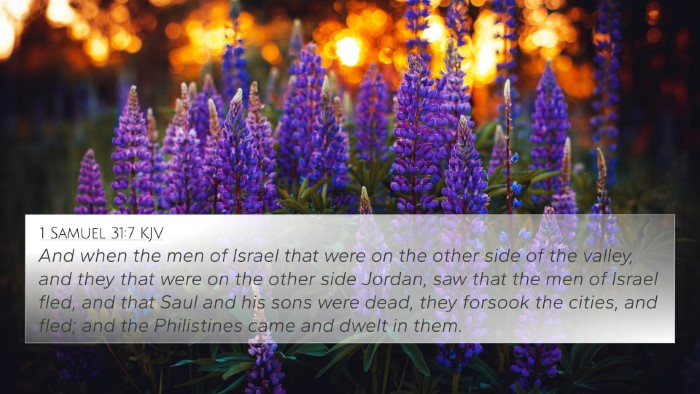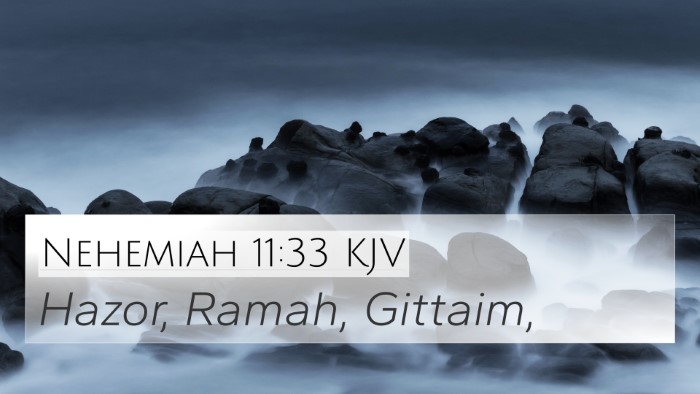Old Testament
Genesis Exodus Leviticus Numbers Deuteronomy Joshua Judges Ruth 1 Samuel 2 Samuel 1 Kings 2 Kings 1 Chronicles 2 Chronicles Ezra Nehemiah Esther Job Psalms Proverbs Ecclesiastes Song of Solomon Isaiah Jeremiah Lamentations Ezekiel Daniel Hosea Joel Amos Obadiah Jonah Micah Nahum Habakkuk Zephaniah Haggai Zechariah Malachi2 Samuel 4:3 Similar Verses
2 Samuel 4:3 Cross References
And the Beerothites fled to Gittaim, and were sojourners there until this day.)
Uncover the Rich Themes and Topics of This Bible Verse
Listed below are the Bible themes associated with 2 Samuel 4:3. We invite you to explore each theme to gain deeper insights into the Scriptures.
2 Samuel 4:3 Cross Reference Verses
This section features a detailed cross-reference designed to enrich your understanding of the Scriptures. Below, you will find carefully selected verses that echo the themes and teachings related to 2 Samuel 4:3 KJV. Click on any image to explore detailed analyses of related Bible verses and uncover deeper theological insights.

1 Samuel 31:7 (KJV) »
And when the men of Israel that were on the other side of the valley, and they that were on the other side Jordan, saw that the men of Israel fled, and that Saul and his sons were dead, they forsook the cities, and fled; and the Philistines came and dwelt in them.
2 Samuel 4:3 Verse Analysis and Similar Verses
Understanding 2 Samuel 4:3
The verse 2 Samuel 4:3 states: "And the Beerothites fled to Gittaim, and were sojourners there until this day." This passage provides insight into the aftermath of political unrest and the fate of the people involved in the conflict during David's rise to kingship. To fully grasp the implications of this verse, we can examine commentaries by notable theologians such as Matthew Henry, Albert Barnes, and Adam Clarke.
Verse Context and Significance
2 Samuel 4:3 occurs within a broader narrative detailing the civil strife following King Saul's death. The Beerothites were inhabitants of Beeroth, a city that belonged to Benjamin. Following the chaos resulting from Abner's death, they fled and sought refuge in Gittaim. This flight indicates not only the physical displacement of a group of people but also serves as a metaphor for the larger turmoil affecting the kingdom of Israel.
Analysis from Commentaries
Thoughts by Matthew Henry
Matthew Henry emphasizes the historical context of the Beerothites' flight, noting that their displacement serves as a warning about the consequences of strife within a nation. He highlights that their stay in Gittaim represents both safety and a loss of identity, as they were exiles from their homeland. Henry also points out the symbolic significance of this migration, linking it to themes of refuge and hardship faced by those caught in political conflicts.
Insights from Albert Barnes
Albert Barnes focuses on the political implications of the event, pointing out that the flight of the Beerothites reflects instability in the region. He suggests that their relocation signifies a breakdown of social order, which is often a consequence of conflict within the kingdom. Barnes also notes that the use of the term "sojourners" implies that their status is temporary, reflecting hope for eventual return and restoration, a theme prevalent throughout biblical narratives.
Exegesis by Adam Clarke
Adam Clarke's commentary elaborates on the location and significance of Gittaim, suggesting that it served as a sanctuary for those fleeing from violence. Clarke indicates that the Beerothites' journey is a representation of the struggles faced by many during times of war and unrest. He connects their fate to the broader narrative of loss and redemption found throughout the Scriptures, illustrating how exile often leads to eventual restoration.
Bible Cross-References
- 1 Samuel 31:1-7 - The aftermath of Saul's death and its impact on the people of Israel.
- 2 Samuel 3:17-21 - Abner's negotiations and the rising tension in Israel.
- Jeremiah 29:4-7 - Exiles in Babylon seeking welfare and peace in a foreign land.
- Hebrews 11:13-16 - The theme of living as strangers and exiles on earth.
- Psalm 137:1-4 - The lament of the exiles in Babylon seeking to remember Zion.
- Isaiah 11:11-12 - God's promise to gather the scattered of Israel, symbolizing hope for return.
- Micah 5:7-8 - Remnant of Jacob among the nations, illustrating a theme of survival and resilience.
Thematic Connections
The context of 2 Samuel 4:3 is rich with themes of displacement, survival, and the quest for identity amidst chaos, which can connect to many other scriptures within the Bible. For instance, the themes of exile and restoration resonate with the experiences of the Israelites in Babylon (Jeremiah 29:4-7) and the reflections on living as exiles in a broader spiritual sense (Hebrews 11:13-16).
Cross-Referencing Biblical Texts
Cross-referencing provides a comprehensive understanding of the Biblical narrative by highlighting how various passages relate to one another. It allows readers to see the overarching themes of struggle, hope, and redemption that permeate the text.
Tools for Bible Cross-Referencing
- Bible Concordance: An invaluable tool for finding connections between terms and themes across scriptures.
- Bible Cross-Reference Guide: Provides comprehensive lists of verses that correlate with specific themes or events.
- Cross-reference Bible Study: Engaging in studies that utilize cross-references can deepen understanding of the Biblical text.
- How to Use Bible Cross-References: Learning the methods for effective cross-referencing enhances theological comprehension.
- Bible Reference Resources: Utilizing various reference materials aids in exploration and analysis of Biblical texts.
User Intent Keywords
In seeking to understand the connections and implications of 2 Samuel 4:3, users may ask questions about related verses, such as: "What verses are related to 2 Samuel 4:3?" or "Find cross-references for 2 Samuel 4:3." The responses can provide a robust framework for interpreting the narrative, highlighting similarities and experiences linked by the common theme of exile.
Conclusion
2 Samuel 4:3 not only communicates historical details but also invites reflection on deeper themes of displacement and identity within a struggling nation. By utilizing cross-references, readers can explore the interwoven narratives of the Bible, leading to a richer understanding of God's relationship with His people amid turmoil.



